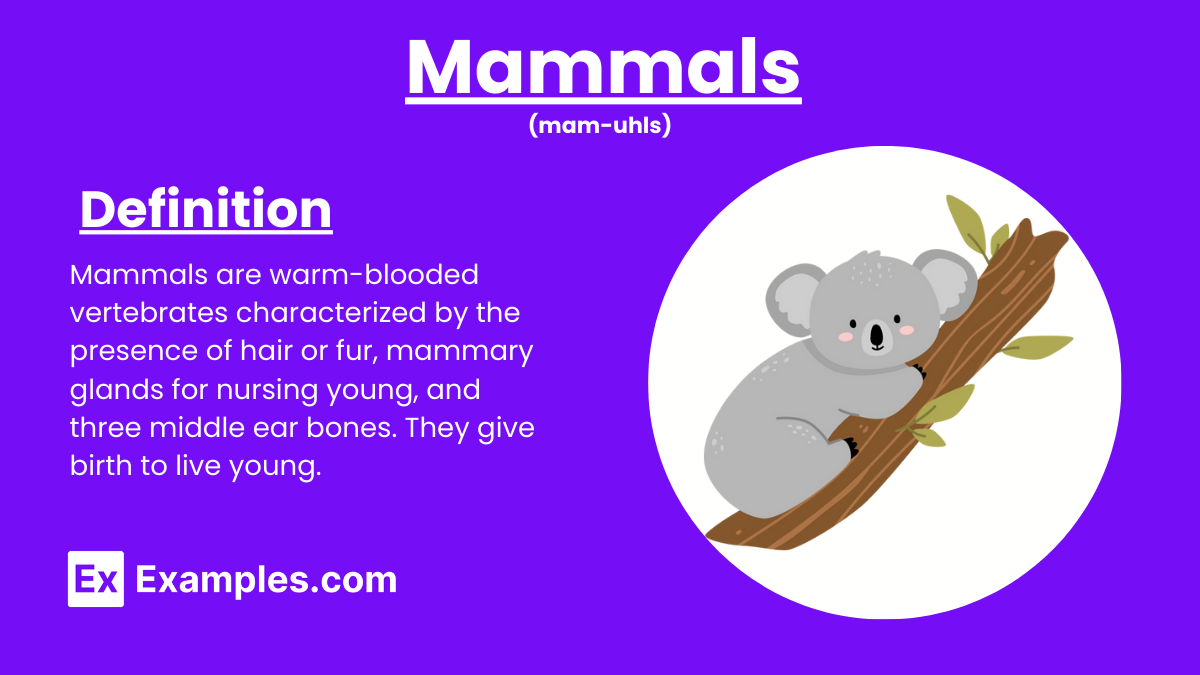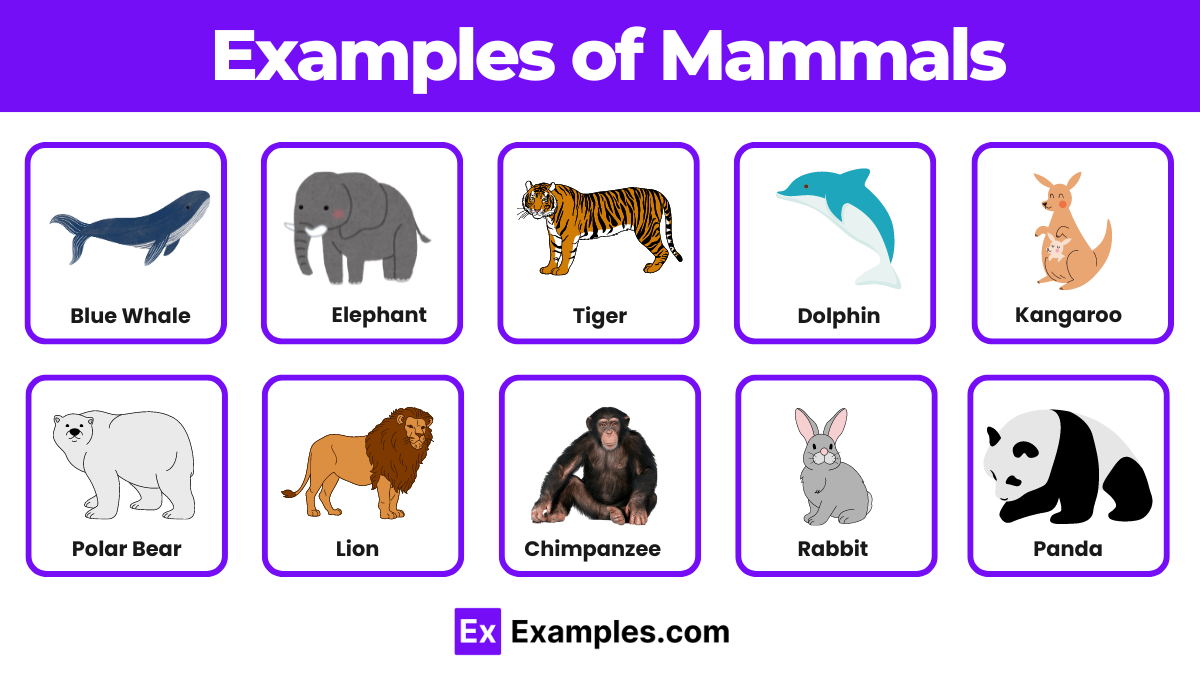Which of the following characteristics is unique to mammals?
Feathers
External fertilization
Hair or fur
Cold-bloodedness


Mammals are warm-blooded vertebrates characterized by the presence of mammary glands, which females use to nourish their young. They also have hair or fur, three middle ear bones, and a neocortex region in the brain. Mammals are diverse, ranging from tiny shrews to enormous whales. They play vital roles in ecosystems across the globe. A mammal greeting card can celebrate these fascinating creatures, highlighting their unique traits and importance in nature.
A mammal is a warm-blooded vertebrate with mammary glands that produce milk for offspring. Mammals have hair or fur, three middle ear bones, and a complex brain. They include diverse species such as humans, whales, elephants, and bats.

Warm-blooded: Maintain a constant internal body temperature.
Hair or Fur: Provides insulation and protection.
Mammary Glands: Females produce milk to nourish their young.
Live Birth: Most give birth to live young, except monotremes.
Four-chambered Heart: Efficiently circulates blood throughout the body.
Specialized Teeth: Adapted for different diets.
Complex Brain: Highly developed brain for advanced behaviors and functions.
Companionship: Pets like dogs and cats provide emotional support and companionship.
Labor: Animals such as horses and oxen assist in farming and transportation.
Food Source: Livestock like cows, pigs, and sheep supply meat, milk, and other products.
Medical Research: Mammals like mice and rats are crucial in medical and scientific research.
Ecosystem Services: Bats and other mammals control pests and pollinate plants.
Cultural Significance: Many mammals hold cultural, spiritual, and symbolic importance in human societies.
Biodiversity Indicators: Mammals often serve as indicators of ecosystem health and biodiversity.
Social Structures: Many mammals, like wolves and primates, live in social groups with complex hierarchies.
Communication: Use vocalizations, body language, and scent marking to communicate.
Parental Care: Most mammals, as heterotrophs, exhibit strong parental care, nurturing and protecting their young.
Foraging: Mammals employ diverse foraging strategies to find food, from hunting to scavenging.
Migration: Some species, like whales and caribou, migrate long distances for breeding or food.
Territoriality: Many mammals defend territories to secure resources and mates.
Play: Juveniles often engage in play to develop social and survival skills.
Resource Protection: Mammals defend territories to ensure access to food, water, and shelter, preventing parasitism and competition by protecting resources from other organisms.
Breeding Rights: Territories help secure mating opportunities by keeping rivals away.
Scent Marking: Many mammals use urine, feces, or gland secretions to mark boundaries.
Vocalization: Sounds and calls are used to warn intruders and assert dominance.
Physical Confrontations: Territorial disputes can lead to aggressive encounters to establish control.
Home Range: Some species maintain a core area for daily activities and a larger home range for resources.
Species Examples: Lions, wolves, and many rodents exhibit strong territorial behaviors.
Ecosystem Roles: Mammals occupy various niches, from predators to herbivores, shaping ecosystem dynamics.
Pollination: Some mammals, like bats, play a crucial role in pollinating plants.
Seed Dispersal: Mammals such as squirrels and monkeys help disperse seeds, aiding plant reproduction.
Pest Control: Mammals like bats and birds of prey control insect and rodent populations.
Soil Aeration: Burrowing mammals, like moles, are part of the fauna that aerate the soil, enhancing its fertility.
Food Webs: Mammals are integral to food webs, providing prey for predators and controlling prey populations.
Habitat Creation: Beavers create wetlands, which benefit numerous other species.
Herbivores: Consume plants, leaves, and fruits; examples include cows and deer.
Carnivores: Eat meat from other animals; examples include lions and wolves.
Omnivores: Eat both plants and animals; examples include bears and humans.
Insectivores: Specialize in eating insects; examples include bats and anteaters.
Frugivores: Primarily eat fruits; examples include fruit bats and some primates.
Sexual Reproduction: Involves the fusion of sperm from the male and an egg from the female.
Internal Fertilization: Sperm fertilizes the egg inside the female’s body.
Gestation: Embryo develops inside the mother’s womb for a specific period.
Live Birth: Most mammals give birth to live young, except monotremes which lay eggs.
Parental Care: Mothers nurse their young with milk from mammary glands.
Reptiles evolved into mammals over millions of years, developing key features like mammary glands and fur. These changes supported the transition to warm-blooded animals, enabling better temperature regulation and adaptation to various environments. Fossil evidence shows intermediate species with mixed reptilian and mammalian traits.
| Aspect | Mammals | Reptiles |
|---|---|---|
| Body Temperature | Warm-blooded | Cold-blooded |
| Skin | Covered with hair or fur | Covered with scales |
| Reproduction | Mostly live birth; few lay eggs | Mostly lay eggs; some give live birth |
| Heart Structure | Four-chambered heart | Three-chambered heart (except crocodiles) |
| Parental Care | Extensive; young are often nurtured and fed | Minimal; young are often independent at birth |
| Respiration | Diaphragm aids in breathing | No diaphragm; lungs use different mechanism |
| Brain Structure | Larger, more complex brain | Smaller, less complex brain |
Most mammals give birth to live young after internal fertilization.
The blue whale is the largest mammal.
Yes, all mammals have some form of hair or fur.
Yes, humans are classified as mammals.
Mammals have diverse diets, including plants, meat, and insects.
Mammals are warm-blooded and regulate their internal temperature.
Mammals have a four-chambered heart.
Yes, all female mammals produce milk to feed their young.
The bumblebee bat is the smallest mammal.
Lifespan varies widely, from a few years to over a century.
Text prompt
Add Tone
10 Examples of Public speaking
20 Examples of Gas lighting
Which of the following characteristics is unique to mammals?
Feathers
External fertilization
Hair or fur
Cold-bloodedness
What type of reproduction is characteristic of most mammals?
External fertilization
Egg-laying
Live birth
Budding
What structure do mammals use to nourish their young?
Feathers
Mammary glands
Sweat glands
Lungs
Which of the following is an example of a marsupial mammal?
Kangaroo
Dolphin
Platypus
Elephant
What type of body temperature regulation do mammals have?
Ectothermic (cold-bloode
Endothermic (warm-blooded)
Poikilothermic
Thermophilic
Which feature distinguishes monotreme mammals from other types of mammals?
Presence of a placenta
Egg-laying
Flight ability
Long gestation periods
Which of the following mammals is classified as a placental mammal?
Koala
Platypus
Human
Kangaroo
Which mammalian characteristic helps with communication and detecting the environment?
Hair or fur
Sweat glands
Specialized teeth
Whiskers
Which of the following mammals is known for being aquatic?
Tiger
Gorilla
Whale
Bear
What is the main function of mammalian lungs?
Digestion
Circulation
Respiration
Reproduction
Before you leave, take our quick quiz to enhance your learning!

